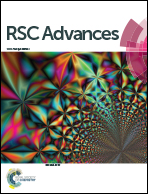Construction of a turn-on probe for fast detection of H2S in living cells based on a novel H2S trap group with an electron rich dye†
Abstract
A turn-on probe (ANR) for fast detection of H2S is constructed based on a 2-(azidomethyl)-4-nitrobenzoate moiety as a trap group. This group is very effective for the design of H2S probes especially with electron rich dyes. The potential biological applications of ANR were proved by employing it for fluorescence imaging of H2S in living cells.


 Please wait while we load your content...
Please wait while we load your content...